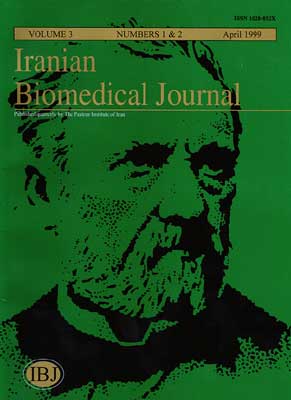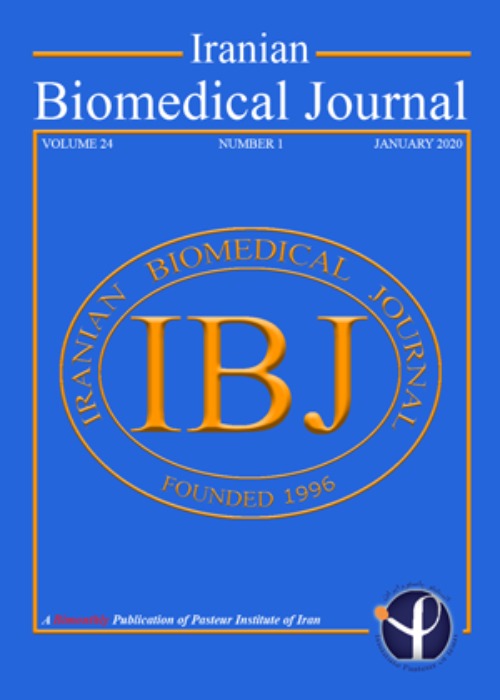فهرست مطالب

Iranian Biomedical Journal
Volume:3 Issue: 1, Apr - Jan 1999
- 62 صفحه،
- تاریخ انتشار: 1379/05/14
- تعداد عناوین: 8
-
-
Page 1The immune system of mammalian organisms undergoes alterations that may account for an increased susceptibility to certain infections, autoimmune diseases, or malignancies. Well characterized are age related defect in T cell functions and cell mediated immunity. Although it is well established that the functional properties of T cells decrease with age, its biochemical and molecular nature is poorly understood. The available data suggest that changes in the signal transduction machinery are responsible for the impairment of T cell function during aging. T cell activation is initiated when an antigenic peptide is recognized by the antigen receptor of T cells. This recognition event promotes sequential activation of a network of signaling molecules such as phospholipases, kinases, phosphatases, and adaptor proteins that couple the stimulatory signal received from T cell receptor (TCR) to intracellular signaling pathways. The coordinate activation of these signaling molecules is sufficient to stimulate the activation of transcription factors and the expression of the immediate early genes that are crucial in regulation of T cell function.Keywords: T cells, Signal Transduction, Aging
-
Page 15This study was planned to determine HIV seroprevalence among pulmonary tuberculosis patients, to characterize the isolated mycobacteria into typical and atypical strains and to evaluate the drug resistant pattern of mycobacterial isolates. The study aims to correlate multidrug resistance (MDR) and HIV seropositivity status in pulmonary tuberculosis patients. During the year 1994-1997, 750 pulmonary TB patients were screened for the presence of anti- HIV 1 & 2 antibodies by commercially available kits of enzyme immunoassay (EIA). Sputum samples were screened for acid fast bacteria by Ziehl-Neelsen technique and isolated on Lowenstein-Jensen (LJ) media. Identification of M. tuberculosis was done by standard biochemical tests. Drug sensitivity testing was carried out using a standard inoculum onto LJ slopes containing different concentrations of 5 anti-TB drugs, namely isoniazid, rifampicin, ethambutol, streptomycin and ethionamide. Out of 750 patients screened, 177 (23.6%) were detected to be HIV seropositive (Group I) and 573 were seronegative cases (Group II). Among these 2 groups, 135 (76.27%) and 473 (82.55%) patients yielded mycobacterial cultures on LJ slopes respectively. Drug sensitive testing revealed 25.19% and 12.05% isolates to be resistant to all the 3 first line drugs namely, rifampicin, isoniazid and ethambutol in seropositive and seronegative groups respectively. From our study it is evident that multidrug resistance has shown a marked increase to the first line anti-TB drugs in HIV seropositive pulmonary tuberculosis patients.Keywords: Drug resistance, HIV infection, Pulmonary TB, MDR, TB
-
Page 23Alpha-1-proteinase inhibitor (API) is one of the acute phase proteins. Following an inflammatory stimuli the concentration of API increased up to four folds. Accompanying these quantitative changes, there is qualitative alterations in the structure of carbohydrate moiety (glycosylation). To determine the alterations in the glycosylation of API in inflammation, API was isolated from the sera of healthy individuals and from patients with rheumatoid arthritis and Crohn’s disease. The isolated proteins were hydrolyzed to release the monosaccharides. Monosaccharide analysis of isolated API was carried out using high-performance anion-exchange chromatography with pulsed amperometric detection system (HPAE/PAD). Using a lectin binding assay (LBA) which was reported recently, the glycosylation of API was further studied. The results of monosaccharide analysis and LBA showed that in inflammation the fucose content of API is increased. Observation from both methods indicated the increase branching of API in inflammation. These findings may help to develop more precise markers for monitoring pathological progression in these diseases.Keywords: Alpha, 1, proteinase inhibitor, Crohn's disease, glycosylation, inflammation rheumatoid arthritis
-
Page 31Both urban and rural cutaneous leishmaniasis (CL) are endemic in different parts of Iran and have long been recognized in most provinces. However, there is no report of endemicity of CL in rural areas of Kashan, 200 km north of Isfahan and 260 km south of Tehran, Iran. To our knowledge, this is the first report of outbreak of cutaneous leishmaniasis in this area. To study and identify the nature of infection in this area, a survey was conducted in a borough, 30 Km south-east of Kashan on 3,530 people, using questionnaire for obtaining clinical status, and leishmanin skin test as an indicator of the prevalence of infection. In addition, 42 lesion samples from patients residing in this area were cultured, which twenty eight of them were positive. By enzyme immunoassay, using three species-specific monoclonal antibodies against common species of Leishmania in Iran, species of isolates were identified. Some of these isolates were also analyzed by PCR. The results showed the prevalence of 6% patients with lesion(s) in the population and 3.1% of people displayed lesion scar(s). Also 12% of population showed sensitivity to leishmanin. In this study the Leishmania major strain was identified in majority of cases, which showed two different patterns when analyzed by PCR. Both patterns belonged to different endemic strains of L. Major in Isfahan, which indicates the possible transmission of infection from Isfahan to this area.Keywords: Identification of species, New Outbreak, Cutaneous leishmaniasis, Leishmania major
-
Page 41Several studies have shown that decidual tissue produces soluble factors which can mediate a variety of immunosuppressive activities. In order to assess whether prostaglandin E2 (PGE2) was present in supernatants produced by explant culture of 10 human specimens of first trimester decidua. The effect of the supernatants from the two different series (with and without indomethacin treatment) of explant culture incubated for 24, 48 and 72 hours on the suppression of PHA-induced lymphoproliferation assay was investigated. The percentage of suppression was evaluated using Student`s t-test. The immunosuppressive activity of decidual explant supernatants was significantly reduced in the presence of indomethacin only in 24 hour culture period. The present study suggests the production of PGE2 by early pregnancy decidua does exist. Whether this molecule is critical for survival of the feto-placental unit requires more investigations, including comparison with nonpregnant endometrium in different cycle phases and investigation of pathological pregnancy.Keywords: Prostaglandin E2, decidua, immunosuppression, Student's t, test
-
Page 47The activity of one of the metabolizing enzymes of ɣ- aminobutyric acid, (GABA), was determined in mouse hypothalamus after peripheral injections of cholecystokinin-8 (CCK-8) and caerulein (CLN). The activity of this rate-limiting enzyme, L-glutamic acid decarboxylase, (GAD), did not change thirty minutes after peripheral injections of either CCK-8 or CLN in doses of 50g/kg body weight. However, the activity of GAD started to increase 24 hours after injection and continued to increase by 15 to 17%, five days after injections. Based on the in vitro models, it has been shown that there are no direct interactions between CCK-8 and CLN and the enzyme GAD. These data probably support indirect but specific interactions between CCK-8, CLN and the enzyme GAD.Keywords: Caerulein, Cholecystokinin, 8, GABA, L, Glutamic acid decarboxylase
-
Page 53A blocker of postsynaptic acetylcholine receptors was isolated from venom of the Eastern green mamba Dendroaspis angusticeps, by gel filtration, ion-exchange and reverse phase high performance liquid chromatography. The isolated component blocks neuromuscular transmission and responses to exogenously applied acetylcholine in isolated chick biventer cervices preparations. These results suggest that postsynaptic blockers exist in venoms of all members of the Dendroaspis genus.Keywords: Dendroaspis, Postsynaptic blocker, Neuromuscular transmission
-
Page 59To improve the specificity of biochemical markers of myocardial infarction (MI) a method to measure cardiac troponin-I (CTn-I) was developed. CTn-I is a protein unique to cardiac muscle and is released after MI. Consecutive 150 patients admitted to the coronary care unit was studied. Value of CTn-I was determined in all samples. CTn-I concentration in the MI patients group was increased compared to that in the control [18.7 +/- 0.13 (mean +/- SD, n = 100) vs. 5.31 +/- 0.13, n = 50] µg/l. Measurement of CTn-I accurately detects MI in patients and should facilitate the diagnosis and management of such patients.Keywords: Cardiac troponin, I, myocardial infarction, creatine kinase


